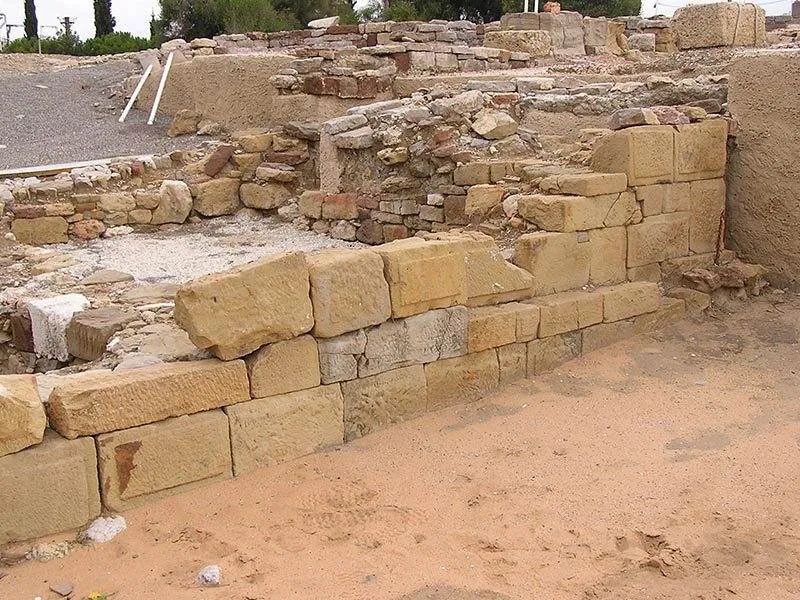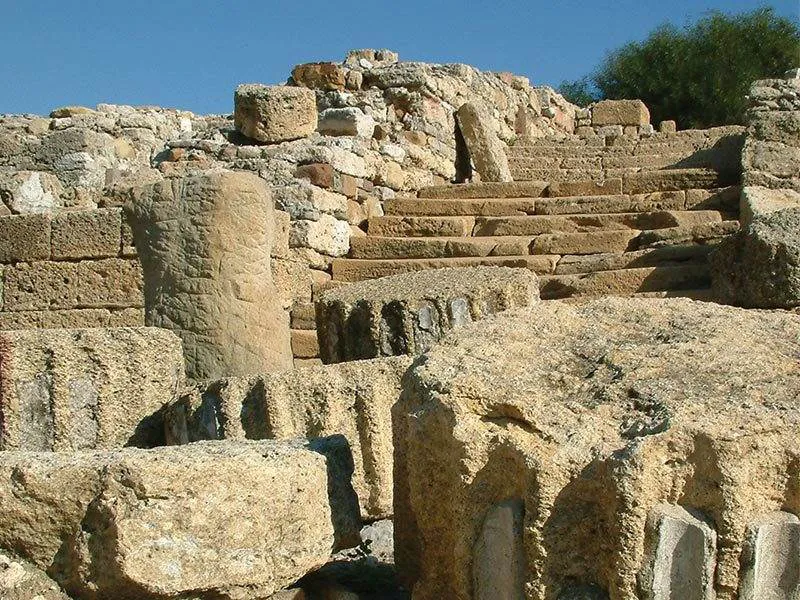Carteia - Phoenician, Carthaginian and Roman ruins near San Roque in Cadiz province, Andalucia, Spain at the head of the Bay of Gibraltar
By Nick Nutter | Updated 12 Mar 2022 | Cádiz | Places To Go |
Login to add to YOUR Favourites or Read Later


Carthagenian Walls
The history of the Roman city of Carteia at the mouth of the river Guadarranque near the present day town of San Roque begins with the Phoenicians who established a settlement a kilometre or so up the river on a small hill now known as Cerro del Prado or Carteia la Vieja. Strabo (64BC – 24AD) writing some nine hundred years later calls the settlement K’rt and says the place was established in 940BC. Archaeological artefacts indicate the settlement was in place during the 7th and 8th centuries BC.
Three hundred years later, during the 4th century BC, the Phoenician influence in the area was declining and their trade was being picked up by the Carthaginians. The settlement at Cerro del Prado was not large enough for the ambitious Carthaginians and the river alongside was liable to silt up so the settlement was re-located to the mouth of the river, at the head of the Bay of Gibraltar, and called Carteia from the Phoenician word qart that means new.
The population of the town became a mix of people related to the original Phoenician traders, native Spanish people of the Turdetani tribes and Carthaginians.
In 237BC Hamilcar Barca, the father of the famous Hannibal and a Carthaginian general, may have landed in the vicinity of Carteia with an army and elephants (other sources indicate he landed near Cadiz). His immediate goal was to wrest control of the gold and silver mining areas of the Sierra Morena from the Iberians. For eight years he expanded the area of Carthaginian influence in Spain. His strategy, using elephants in battle, may well have given Hannibal, who as a nine year old had accompanied his father on the Spanish expedition, the idea for his famous exploits during the Second Punic War that broke out in 218BC.
The Second Punic War ended in 201BC after Hannibal was finally defeated at the Battle of Zama near Carthage in North Africa. However the Carthaginians had been driven out of Spain in 205 BC, never to return. The citizens of Carteia had played little part in the war, only being mentioned once as the port to which Adherbal, the Carthaginian Governor of Gades (Cadiz), had retreated following his defeat at the naval Battle of Carteia at the hands of the Commander of the Roman fleet Gaius Laelius in 206BC. The citizens of Carteia could not have been too impressed since, following the defeat of the Carthaginians at Ilipa earlier the same year, the citizens of Carteia led by the Turdetani had decided to ally themselves with Rome. This alliance stood them in good stead when in 190BC the administration of the town was finally taken over by the Romans.


Roman Aggregate
The event must have been a peaceful one, and preceded by a considerable Roman presence for by 171BC, barely nineteen years later, there were 4,000 Romano Spanish people, the sons of Roman men and Spanish women, living in Carteia. Livy (64BC – 17AD) tells us that in 171BC the Roman senate received a petition from Carteia. As a result the town was granted the status of a colonia. This gave the 4,000 Romano Spanish people a grant of land on a similar basis to Roman colonists. The existing citizens to remain there and all the inhabitants were given the right to marry Roman citizens and to trade with Rome. Carteia was the first town outside Italy to receive this civic status and led the way for other towns in Spain to be granted similar rights.
Carteia prospered and grew to be a city port that acted as a trade centre for Spanish produce, garum, wine, fish sauce, olives and other agricultural products. It had its own kilns producing amphorae, a mint and the full suite of Roman public buildings, an amphitheatre, temples and forum.


Roman Columns
In 68BC Pompey had his headquarters there whilst he suppressed Mediterranean pirates. Pompey’s sons, Gnaeus and Sextus, raised an army at Carteia in 45BC to oppose Julius Caesar who was waging a civil war against the Roman Republic. They were defeated at the Battle of Munda, the final battle of Caesar’s campaign. Gnaeus was executed but Sextus escaped via Carteia.
Caesar appears not to have exacted any retribution from Carteia itself and its continued history mirrors that of the Roman Empire; initially continuing to grow and prosper and then declining towards the 4th Century AD as the fortunes of the Empire itself declined. Rome withdrew from Western Europe leaving the way open for the Visigoths who arrived in Carteia towards the end of the 5th Century.


Plaster Coated Wall Decoration
They occupied Carteia building a necropolis on the site of the Roman temple. The Romans returned briefly when, in 552AD Byzantine forces landed somewhere near the Guadalette river in Cadiz province according to one source or Malaga according to others. Over a period of two years the Byzantines managed to conquer a coastal strip of land running from the Portuguese border to Cartagena. They called it Spania.
Spania was never intended to be much more than a bulwark against the Visigoths, protecting the Byzantine possessions in North Africa and by 624AD the Visigoths had regained control over all the Byzantine towns on mainland Spain.
By the time of the Moorish invasion of 711AD when Tarik and his forces landed somewhere between Algeciras and the mouth of the Guadiaro river Carteia was once again in decline, little more than a dilapidated village. The Moors did construct a tower at the site known as the Torre de Cartagena using stone from the Roman buildings but their main defensive position was Gibraltar, just across the bay from Carteia and Carteia was little more than a military establishment to support Algeciras itself destroyed by the Visigoths and subsequently rebuilt by the Moors, the first city created on Spanish soil by the new invaders.


Visigothic Necropolis
Carteia was abandoned entirely after the Moors were expelled from Spain. It is possible that it suffered the same fate as Algeciras. That city was destroyed in 1368 on the orders of Muhammed V of Granada and not re-founded again until 1704 when refugees from Gibraltar came to live in the area. By this time Carteia had been forgotten, or at least incorporated into a farm and was re-discovered by a British army officer called John Conduitt between 1713 and 1717.
He was invited to present a paper on his discovery which he did in 1717 in front of Sir Isaac Newton. Newton at the time was writing his ‘Chronology of Ancient Kingdoms’ but it was nearly another hundred years, 1811, before Vice Admiral Charles Penrose reached an agreement with the estate owners to allow amateur archaeologists from Gibraltar to start excavating the site.


Visigothic Necropolis
Excavations continued sporadically until the 1960s by which time the encroaching development of an oil refinery had destroyed the city gates and Roman necropolis. It was then, belatedly, given protection. The tower you see today is built on the site of Torre de Cartagena but dates back to the 16th Century and was one of the torres built to warn of Barbary pirates. It is called the Torre de Rocadillo.
Check out opening times for Carteia here
Take exit 116 from A7 towards Guadarrangue. Continue through the oil refinery works and the entrance is on the left.